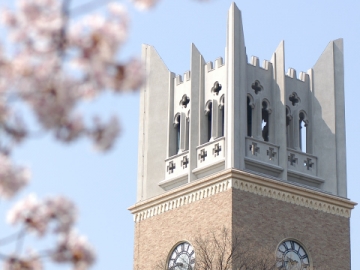Spring break staycation: an international student’s suggestions for recharging between semesters
Thu, Feb 24, 2022-
Tags
After closing out the fall semester at Waseda in January, we’re now coasting through the calm of a two-month hiatus until the 2022 academic year officially commences in April. It’s a curious rhythm for those of us who are used to a school year that spans late summer to mid-spring. That said, two months is a luxurious amount of time compared to the one-week break that’s standard in other countries. If you’re here in Tokyo, this is the perfect occasion to explore the city at your own leisure. But there are ways to stay connected to Waseda and Japan no matter where you are—check below for some ideas!
For many people around the world, the idea of springtime in Japan immediately conjures up the delicate pink palette of sakura (cherry blossoms). Cherry blossom imagery is indeed ubiquitous here: from scenes in films, television dramas, and anime to advertisements for domestic travel, packages of potato chips, limited edition beverages, what have you. The cherry blossoms on campus at Waseda provide a most timely and picturesque backdrop for the arrival of new cohorts in April, as well as the return of students and faculty getting back to the grind.

Cherry blossoms at the Central Library on Waseda Campus.
With three semesters under my belt, the arrival of spring break means I’m officially halfway done with my program. The feedback from my professors at my preliminary exam has been invaluable; I feel like the outline of my project is warping and shifting as I try to distill a whole assortment of disparate but interconnected ideas into something more pithy. No matter how succinct a research topic I articulate, it ought to be something that merits a deep dive—to the tune of 70,000 words in English, the minimum length requirement for the doctoral thesis at the Graduate School of International Culture and Communication Studies (GSICCS).
I’m letting myself relax a little so my thoughts can sort themselves out. Meanwhile, I’ve been working on some freelance translation and fiction writing while engaging a few online teachers for Japanese conversation practice. Besides getting my academic life in order, I have no plans for this break except to take it real easy and stumble around town as the weather warms up. The omicron surge has been tough, but it looks like cases are steadily declining and the government is considering easing border controls again. I’m looking forward to meeting the students who have been waiting to enter Japan, including a number of my zemi classmates.

New students on campus during last year’s April entrance ceremony.
Some recent highlights of my break thus far have been a satisfyingly spicy hot pot meal in Ueno and a trip to Shimokitazawa to see Ryusuke Hamaguchi’s Wheel of Fortune and Fantasy at a newly opened movie theater called K2. I was utterly bowled over by this film’s meditations on chance and fate, and how our lives can be profoundly affected by the most mundane of actions. K2 offers select screenings with English subtitles, an amazing boon to international audiences in Tokyo. I’ll definitely be going back next month when they show Hamaguchi’s latest work, Drive My Car, which was recently nominated for several Oscars.

A spicy hot pot meal in Ueno, about a 30 minute train ride from Waseda Station.
While school is out of session, many students are putting in more time at part-time jobs or catching up on life outside academia. But it’s always good to give yourself a real break where possible. Besides going to the movies, what else is there to do for a Waseda student? Here’s a short list of recommendations for outings around Tokyo, as well as online diversions for those who may be tuning in from home.
- Scope out an exhibition: There are tons of museums around town, running the gamut from more traditional spaces like the National Museum of Modern Art Tokyo to niche interests like the newly opened Tokyo Tarot Museum. Personally I really enjoy the Tokyo Photographic Art Museum in Ebisu (about 25 minutes from Waseda by train) and, of course, the Ghibli Museum in far-flung Mitaka (about 45 minutes away). Don’t forget to confirm the museum hours or book your tickets in advance, if possible, as most establishments have timed entry by the hour or half hour.
- Stream a show or two: “Improving Japanese listening comprehension” is a great excuse to explore the array of programming available on various streaming platforms. I never really watched much anime until I started to learn Japanese a few years ago, but it’s been interesting to see how an American company like Netflix has invested in the genre through the distribution of titles like Aggretsuko, The Great Pretender, and The Orbital Children. Also, American reality TV franchise Love is Blind just dropped their Japan season. I’m not saying that I watched it, but I’m not not saying that I watched it…
- Take an overnight trip: Cold weather in Japan is perfect for a soak in the hot springs. Hakone and Atami are both reachable within two hours from Tokyo and provide some welcome respite from the congestion of urban living. There’s also Kamakura and getaways closer to home, if you’re in the mood to admire a large Buddha, enjoy some nature, or simply stroll around a smaller town. I hear Chiba has some great outdoorsy stuff, too.

The Great Buddha of Kamakura, accessible by the JR Shonan Shinjuku line.
- Groove nostalgic: To the bewilderment of many Japanese, the synth-heavy ballads of city pop have become somewhat of a phenomenon in the Euro-American world. These tunes hearken back to Japan’s bubble era and evoke a cheery capitalist heyday of boxy cars and even boxier clothes. You’ll find tons of stuff on YouTube if you want to explore it on your own, but you can also look to contemporary DJs like Night Tempo to guide you through the hits.
- Discover your new favorite kissaten: The traditional Japanese café is the perfect spot to hole up with a warm beverage and a good book on a cold day. There are hidden gems to be found in every ward if you walk around long enough. You can also save time and get your recommendations on picturesque kissaten from other sources, like this list from Time Out Tokyo. Steeping in those Showa vibes, ordering some sweets; it’s kind of like Japanese-style hygge, no?

Vienna coffee in Ueno.
- Browse the Haruki Murakami Library’s online content: Did you know there’s a virtual annex to the Waseda International House of Literature (aka the Haruki Murakami Library)? The physical facilities still require a reservation—except for walk-in hours if you have a student ID—but there’s a nice crop of essays, interviews, and videos accessible to anyone at any time. Newly opened in 2021, the Library has already become a fixture of the Waseda community, honoring the work of one of the university’s most influential alumni.

The iconic bookshelf staircase of the WIHL.
- Explore the world of secondhand: Tokyo is a wonderful place to hunt for vintage clothing. Shimokitazawa and Koenji (30- and 15-minute train rides from Waseda) are probably the two areas where you’ll find the highest concentration of stores, as well as a range of eateries to rest your weary feet. Come for the shopping, stay for the people-watching. Ask your local friends for their favorite spots, too. There are some pretty spiffy places in unlikely neighborhoods.
- Find a Japanese podcast: That listening comprehension thing again. Podcasts are a great low-stakes way to keep up with language learning, especially if you’re outside of Japan. Poke around on Spotify, or check out some of the Japanese language teachers on YouTube; oftentimes they’ll add transcripts or captions to their content that can help you follow along. Here at the university, the Intercultural Communication Center (ICC) recently released their dual Japanese/English podcast called ICC Radio: Voices of Waseda featuring both Waseda students and staff.
Of course, this list is completely subjective and I’m sure every reader will have their own additions, based on hobbies or other interests. No matter where you are or what stage of your studies you happen to be at, I hope you find time to relax and recharge. Self-care is important, after all. Stay safe and see you in April!
*This article was written and contributed by the following student.
Student Contributor
Mike Fu
Graduate School of International Culture and Communication Studies














